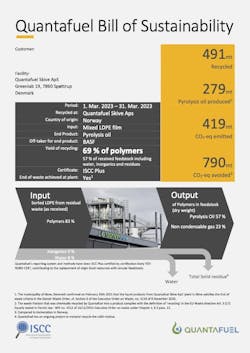Digitalization Meets Sustainability in the Chemical Industry
In an era where decarbonization and digitalization are increasingly recognized as pivotal forces shaping industries, the chemical sector stands at a critical junction. Dow's $67 billion ethylene project exemplifies this convergence, demonstrating how digitalization is not only enhancing operational efficiency but also facilitating sustainability goals.
Meanwhile, companies like Exxon Mobil are strengthening their commitments to open automation. Digital technologies also are playing an integral role in the growth of emerging chemical sectors like plastics recycling.
Quantafuel, a Danish subsidiary of Viridor, specializes in converting post-consumer plastic waste into valuable feedstocks. The company has embarked on a major digitalization initiative to ensure traceability and drive efficiency in a competitive market.
The chemical industry, known for its cautious approach to embracing interconnected technologies, is increasingly accelerating adoption of these solutions. In many cases, chemical producers have little choice. A case in point is the U.S. Environmental Protection Agency’s updated hazardous air pollution standards for synthetic organic chemicals.
According to EPA estimates, the industry can expect to pay about $1.8 billion over 15 years to comply with the standard. To optimize resources and minimize costs, facilities will likely need to further integrate sensing technologies with business intelligence and enterprise systems.
Understanding Data Via Open Process Automation
The movement is a major shift of thinking for an industry that has, at times, been resistant to change. One of the major struggles for chemical manufacturers isn’t so much accessing the data but being able to make sense of it with so many different systems in place speaking different languages.
“They (chemical companies) like the idea of doing more with data, but they don't know necessarily where to begin, and they don't have the right technologies in the right place to do that,” says Gregory Tink, director of digital transformation consulting for industrial automation provider Schneider Electric.
This is where standards, interoperability and integration become critical. Technology vendors, such as Schneider Electric, have been working to develop open automation standards that enable more communication between systems. Earlier this year, Schneider Electric announced the release of a distributed control node software framework developed in collaboration with Intel and software company Red Hat. The framework is aligned with Open Process Automation (OPA) Forum goals for interoperability and portability.
The OPA Forum is a group of end users, system integrators, suppliers, academia and standards organizations focused on developing a standards-based, open, secure, interoperable process control architecture.
Exxon Mobil’s version is about to be deployed for operations. The company has been testing the system for about two years at a chemical facility in Baton Rouge, Louisiana, says Ryan Smeltzer, automation program manager, Exxon Mobil Technology and Engineering Company.
Exxon Mobil’s OPA project is in the engineering and staging phases, writes Jim Montague, executive editor of Control Global, a magazine published by CP parent company Endeavor Business Media.
As Dave DeBari, OPA technical team leader at Exxon Mobil and co-chair of OPAF’s application portability subcommittee, explains in the Control Global article:
“Open process systems unlock value by decoupling and separating software from hardware to allow better real-time control and performance. This is technology we can set up and use today because it only takes 18 minutes to set up and fully commission a DCN in our testbed using orchestration script to safely deploy and run embedded control code. We never have to say ‘no’ to a project now because this kit can do it.”
Another factor in the interoperability equation is data modeling. This is the sustainability target. Data modeling is a process for standardizing data collection and contextualizing it with various identifiers, such as time-series data, events or 3D models of a plant or equipment.
Quantafuel partnered with data-modeling software company Cognite to develop a platform for its digitalization project at its production facility in Skive, Denmark. The facility processes mixed plastics waste and turns it into pyrolysis oil that it ships to BASF for use in BASF’s ChemCycling chemical recycling project. It’s a continuous processing plant similar to an oil and gas facility.
Quantafuel wanted to analyze its chemical recycling process and monitor its operational CO2 emissions in near-real time. But the data the company needed existed in a wide range of formats from various systems. Much of what the company is collecting at the plant is time-series data, says Thomas Lier-Nilsen, Quantafuel’s operations manager.
“We have a lot of valves opening and closing, and we have a lot of motors and pumps starting and stopping,” he explains. “To live stream all that data, that was really a challenge.”
The company launched the initiative in 2021 to extract data from various programs, such as its MES and SCADA system, and make that operational data available across the company, says Thomas Lier-Nilsen, Quantafuel’s operations manager.
Data Modeling Offers Baseline Information
Quantafuel conducted the project in phases. The first phase involved collecting data from the SCADA system, contextualizing it within the Cognite data-modeling platform and then connecting it to a data-analytics system. In phase two of the project, Quantafuel began collecting MES data, which includes the types of plastic, how much it collected, when it arrived at the plant and how much oil it loaded onto trucks.
Data modeling is a way of standardizing raw data using common attributes for a particular event or instance. These standardized models provide a type of “dictionary,” or baseline data set to work with, explains John Harrington, chief product officer at HighByte, for an article in Smart Industry, also published by Endeavor Business Media. HighByte is a provider of a data-modeling platform called the Intelligence Hub.
For Quantafuel, having consistency and uniformity across different systems, application and processes was critical for tracking emissions and developing its “bill of sustainability.” This is a document similar to a bill of lading that provides information on the amount of plastic waste the company produces and the corresponding CO2 profile (Figure 1).
“Going forward, we might need to compete for this plastic," Lier-Nilsen explains. "Good traceability will be a competitive advantage."
The bill of sustainability allows the company to provide a report in near real-time to customers and suppliers.
“We weren’t able to do that earlier,” Lier-Nilsen says.
“That's more event-type of data,” Lier-Nilsen says. “Putting it together was really useful for us seeing the different performance (variables) in the operation of the plant.”
Having standardized data has also helped Quantafuel measure and track its emissions more effectively. For example, the company uses analyzers on all the major CO2 emission points to continuously measure all of its emissions.
Lier-Nilsen describes the data-modeling platform as a type of “operating room” where the operations team can look at trends and export the data from the three analyzers into a spreadsheet. They can drill down into individual assets within the plant and view time-series data based on predefined rules.
“That sort of channel of live operational data just streams in, and we can browse them by tag,” Lier Nilsen says. “Then, we can say, ‘Give me these three analyzers and the gas and the electricity consumption’ and look at the graphs. And then, we can see, for example, that the composition of the electricity is fairly stable. You can then do calculations to get one final curve.”
Embedding Digitalization To Drive Sustainability
Dow’s ethylene project in Fort Saskatchewan, Alberta, Canada, represents another instance of digitalization converging with sustainability. The plant, which will produce and supply approximately 3.2 million metric tons of polyethylene and ethylene, is part of the company’s Path2Zero initiative to reach carbon neutrality by 2050.
Billy Bardin, Dow’s global climate transition director, discussed during the ARC Advisory Group Forum in Orlando on Feb. 7 how the company is embedding digitalization throughout the entire design plan for the plant.
“When we look at the facility, we’re trying to understand how we digitize the facility from the start, so that we can get to this track and trace of emissions and being able to audit and verify and assure that those emissions are tallied correctly,” Bardin said during his presentation.
Part of the carbon-tracking challenge is identifying emissions monitoring systems that can integrate between the process control system and the ERP, Bardin says.
“We want to find unified tools that will allow us to have easier global visibility than we have today,” he told Chemical Processing following the panel discussion. “We have global visibility today, but there’s still a lot of manual intervention, so we’re looking for capabilities that integrate across the stack.”
Bardin stressed the importance of ensuring that these systems seamlessly exchange data across different platforms. This flexibility is crucial to avoid reliance on a single vendor for a comprehensive solution – from ERP to control-room operations. The systems should facilitate easy communication with one or two other platforms, enabling efficient data transfer to a cloud environment for analysis and monitoring, he says.
Enabling sustainability through digitalization also requires close collaboration between an organization’s environmental team and the IT or digital-transformation unit, remarked Nathalie Marcotte, senior vice president and president of process automation for Schneider Electric, during the same session that Bardin participated in. This alignment makes sustainability data more available across the organization, so everyone feels like they’re a part of the journey, Marcotte said.
Dow, for example, has begun looking at individuals who have technology and environmental experience.
“We are now looking at individuals that have experience in data science and architecture with environmental background,” Bardin told ARC attendees. “We're growing some of those internally.”
About the Author
Jonathan Katz
Executive Editor
Jonathan Katz, executive editor, brings nearly two decades of experience as a B2B journalist to Chemical Processing magazine. He has expertise on a wide range of industrial topics. Jon previously served as the managing editor for IndustryWeek magazine and, most recently, as a freelance writer specializing in content marketing for the manufacturing sector.
His knowledge areas include industrial safety, environmental compliance/sustainability, lean manufacturing/continuous improvement, Industry 4.0/automation and many other topics of interest to the Chemical Processing audience.
When he’s not working, Jon enjoys fishing, hiking and music, including a small but growing vinyl collection.
Jon resides in the Cleveland, Ohio, area.


